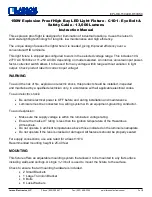
KTR-STOP
®
S-xx-F B-xx
Operating/Assembly instructions
KTR-N
Sheet:
Edition:
44590 EN
21 of 26
3
Please observe protection
note ISO 16016.
Drawn:
2018-09-10 Shg/Wie
Replacing:
KTR-N dated 2018-02-07
Verified:
2018-09-10 Shg
Replaced by:
Mount the pad retraction set on the movable side (component 8) by shifting the pressure spring (component
8.2) onto the pin (component 8.1). Screw the pin with the pressure spring into the brake pad against a stop.
Repeat this process with the pad retraction set on the moveable side of caliper (component 6).
Secure the screw connection (component 6.1 and 8.1) on the brake pad additionally against
working loose, e. g. conglutinating with Loctite (average strength).
Repeat chapter 4.5
Setting/re-adjustment of the centering system
and chapter 4.9
Setting/re-adjustment of the
brake
.
Please make sure that the brake disk can rotate freely while not touching the brake pads or the brake caliper.
To facilitate the replacement of the brake pads you can unscrew the screws of the connec-
tion plate and remove 3 out of the 4 screws alternatively. Swing the brake out of its position.
Please note chapter 4.4
Assembly of the brake
.
Before you reactivate the brake, please observe chapter 4.8
Start-up of the brake
.
To ensure the full braking power, both disassembly and assembly have to be performed at
the highest level of purity.
Disassemble the brake, please observe chapter 4.11
Disassembly of the brake
.
Remove the pad retracting sets (component 6 and 8).
Take out the brake pads (component 7) and the distance
plates (component 2).
Remove the sealing plugs from the external centering
system (component 4.4). Untighten the hexagon nuts
(component 4.3) and unscrew the cap screws (compo-
nent 4.1) from the base plate.
Remove the brake caliper (component 1) from the guide
pin (component 3).
Illustration 20: KTR-STOP
®
XS-xx-F B-xx
!
Inspect the components/component as-
semblies 2, 3 and 4 for any kind of dama-
ge; it may be necessary to replace the
components.
Afterwards remove dirt, grease and corro-
sion from the components.
5
Maintenance
5.1 Replacement of brake pads
5.2 Maintenance of the brake / replacement of single parts






































